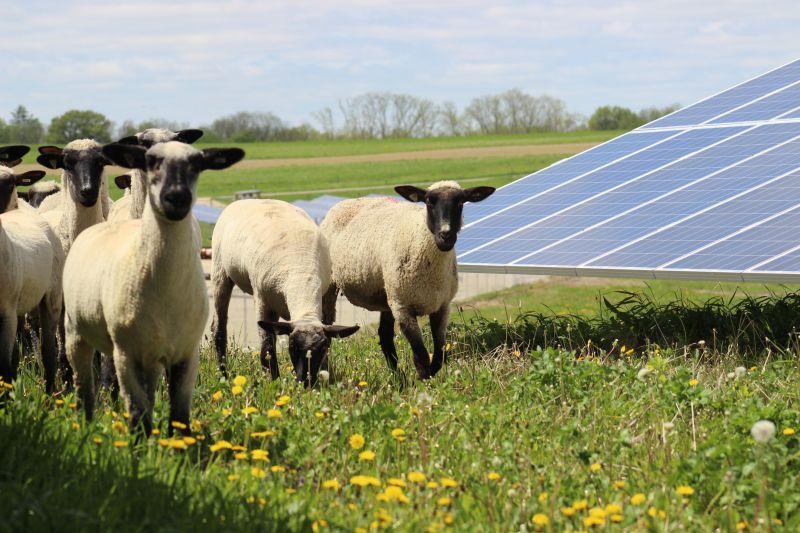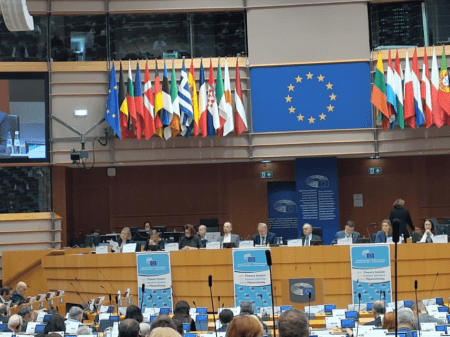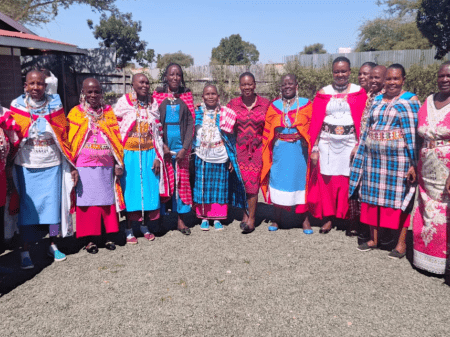
Pollinators and lambs may not be the first thing that crosses one’s mind when thinking about solar plants. Yet three electric cooperatives in the USA are showing they can keep solar projects green by creating the right conditions for wildlife to flourish among their solar plants.
Vernon Electric Cooperative constructed a 305 KW community solar project in 2014, the first community solar project in Wisconsin. The cooperative’s members purchased 1,000 solar panels made available by the cooperative within two weeks.
Since the community solar array sits in a field surrounded by a fence, the solar panels in the array were lowered to be closer to the ground to be less noticeable by surrounding neighbours. This meant that grass was able to grow high enough to shade portions of the panels, reducing productivity.
“We didn’t like the prospect of added cost, added CO2 emissions, and added risk of damage to the solar panels from a giant gas-powered mower zooming around the array every two weeks,” said Dave Maxwell, director of marketing and communications at the cooperative.
The solution came from the cooperative’s CEO, Craig Buros, who happened to have two children who were raising sheep to show at a local county fair. The original land mowers proved to be a great ethical alternative.
“He offered to put the sheep in the fenced-in yard of the array to see if they could help keep the plants under control without causing any damage to the solar panels. Unlike goats, we didn’t think the sheep would try to climb on the solar panels or nibble on the wires. We gave it a try and it worked out great. But our CEO’s children only had five sheep. We needed more,” added Mr Maxwell.
He recalls how, while at a family get together watching the Green Bay Packer football game at a relative's house, he met someone who happened to raise draft horses and sheep.
“We started talking about the idea of using sheep to manage vegetation around the community solar array. He loved the idea of having a place to keep some of his sheep during the summer and offered to bring over as many as we needed. The handshake deal was done. We’re going on our sixth summer now with his sheep trimming the grass and vegetation. Since we have harsh winters here in Wisconsin, we only have to worry about vegetation in the spring and summer. The sheep usually arrive in mid-May and are no longer needed by the end of August.”
The approach is not without challenges, said Mr Maxwell. The sheep need water and there is no natural water source available at the array. Therefore, the cooperative has to haul water one or two times a week to re-supply a stock tank that has been set up within the fence.
“The other downside is that the sheep don’t like thistles, and our thistles can get up to six feet high. So, once a summer, we hire someone to carefully mow the field or I walk through the array field and chop down the thistles by hand. To anyone considering controlling vegetation around solar panels with sheep, I would recommend it, but one of the first things to consider is how are you going to keep the sheep watered,” added Mr Maxwell.
The solution is inspiring other electric cooperatives. Eau Claire Energy Cooperative, which provides energy to 11,000 customers in Eau Claire County, started using the four-legged mowers in 2016 on its five-acre plot of land featuring over 2,800 solar panels.
Likewise, in 2019 Wright-Hennepin Cooperative Electric Association (WH) converted 1.25 acres of land near two WH solar communities at its Rockford headquarters into a pollinator garden. The property will provide habitat for birds, bees, butterflies and other wildlife and turn unused land into a useful resource.
Andrea Unger, marketing and member service director at WH, commented shortly after the launch of the pollinator garden project in late 2019: “We believe the planting will help the environment as it provides a habitat for bees and other pollinators, butterflies, birds and more. It will also provide beauty for the employees who take walks around campus during break times and the members who come to see their solar arrays. We look forward to seeing what kinds of creatures make this area their home.”
Through these projects, the cooperatives are aiming to make renewable energy more wildlife friendly.
Photo credit: Vernon Electric Cooperative




